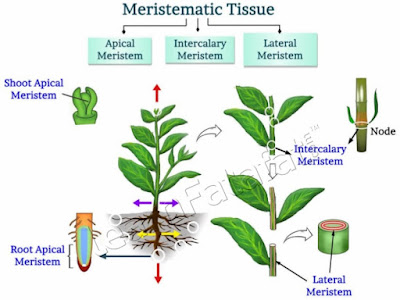Meristems are regions of actively dividing cells in plants, which are responsible for the growth and development of plant tissues and organs. Based on their location and function, meristems are classified into three types:
1. Apical meristem:
Apical meristem is present at the tip of the shoot and root of the plant, and is responsible for the primary growth of the plant. The cells of apical meristem divide rapidly and differentiate into various types of cells, which form the primary meristems that give rise to the different tissues of the plant.
2. Lateral meristem:
Lateral meristem is present in the lateral regions of the plant, and is responsible for the secondary growth of the plant. The cells of lateral meristem divide rapidly and differentiate into two types of meristems - the vascular cambium and the cork cambium. The vascular cambium gives rise to secondary xylem and phloem, while the cork cambium gives rise to cork cells that form the outer bark of the plant.
3. Intercalary meristem:
Intercalary meristem is present in the internodes of the stem, and is responsible for the elongation of the stem. The cells of intercalary meristem divide rapidly and differentiate into various types of cells, which contribute to the elongation of the stem.
The classification of meristems is based on their location and function, and each type of meristem is responsible for different aspects of plant growth and development.

Comments
Post a Comment